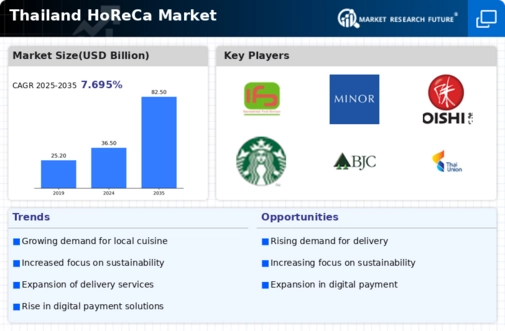The horeca market in Thailand is characterized by a dynamic competitive landscape, driven by a combination of consumer preferences, technological advancements, and evolving operational strategies. Major players such as Compass Group (GB), Sodexo (FR), and Marriott International (US) are actively shaping the market through various strategic initiatives. For instance, Compass Group (GB) emphasizes innovation in food service management, focusing on sustainability and health-conscious offerings, which resonates with the growing demand for healthier dining options. Meanwhile, Sodexo (FR) has been expanding its footprint in Thailand by enhancing its service delivery through digital platforms, thereby improving customer engagement and operational efficiency. These strategies collectively contribute to a competitive environment that is increasingly focused on quality, service differentiation, and technological integration.
The business tactics employed by these companies reflect a nuanced understanding of local market dynamics. Localizing supply chains and optimizing operational processes are critical for maintaining competitiveness in a moderately fragmented market. The presence of key players like Aramark (US) and Elior Group (FR) further intensifies competition, as they leverage their global expertise to adapt to local tastes and preferences. This collective influence of major companies fosters a competitive structure that encourages innovation and responsiveness to market changes.
In October 2025, Marriott International (US) announced a strategic partnership with a local tech firm to enhance its digital guest experience through AI-driven personalization. This move is significant as it aligns with the broader trend of digital transformation in the hospitality sector, allowing Marriott to offer tailored services that meet the evolving expectations of tech-savvy consumers. Such initiatives not only improve customer satisfaction but also position Marriott as a leader in leveraging technology for operational excellence.
In September 2025, Sodexo (FR) launched a new sustainability initiative aimed at reducing food waste across its operations in Thailand. This initiative is particularly relevant given the increasing consumer awareness around environmental issues. By implementing waste reduction strategies, Sodexo not only enhances its brand image but also aligns with global sustainability goals, potentially attracting a more environmentally conscious clientele.
In November 2025, Compass Group (GB) unveiled a new menu concept that emphasizes locally sourced ingredients, reflecting a growing trend towards sustainability and localism in the horeca market. This strategic move is likely to resonate with consumers who prioritize fresh, locally produced food, thereby enhancing Compass Group's competitive edge in a market that values authenticity and quality.
As of November 2025, the horeca market is witnessing significant trends such as digitalization, sustainability, and the integration of AI technologies. These trends are reshaping competitive dynamics, with strategic alliances becoming increasingly important for market players. The shift from price-based competition to a focus on innovation, technology, and supply chain reliability is evident. Companies that can effectively differentiate themselves through these avenues are likely to thrive in an evolving landscape, where consumer expectations continue to rise.

















Leave a Comment